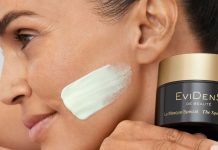Whether you’re in your 20s or in your 50s, we all want to have a clear, crisp complexion. But skin pigmentation disorders can happen and pesky dark spots can wreak havoc on your fresh-faced appearance.

Skin pigmentation disorders affect your skin’s color. You get your skin color from a pigment known as melanin. When melanin-producing cells are unhealthy or become damaged, it can drastically increase the amount of melanin they produce, resulting in discoloration and dark areas on your skin. Some of these disorders can only affect your face while others can affect your entire body. Skin pigmentation disorders can happen for a variety of reasons, including sun and UV ray exposure, medications, pregnancy, genetics, skin aging, and more.
Types of Skin Pigmentation Disorders
There are a number of skin pigmentation disorders that can afflict you, such as sunspots, freckles, melasma, post-acne pigmentation, computer radiation spots, age spots, and post-inflammatory hyperpigmentation.
Sunspots and freckles are the most common skin pigmentation pests. Sunspots, also known as solar lentigines, are typically light to dark brown in color. Many people confuse them with skin cancer, but sunspots are not harmful to your health. Sunspots can appear on your face, arms, and chest. The main cause for sunspots is overexposure to the sun’s harmful UV rays. UV rays can cause our body’s melanin-producing cells to work double time, causing these dark spots.
Melasma causes dark, discolored patches to appear throughout your body and face. People with darker skin tones have a higher risk of developing this skin disorder than those with fair skin. Hormone imbalances due to birth control or pregnancy can trigger this disorder, as well as thyroid diseases and stress. Additionally, sun exposure may put you at risk for melasma.
Post-acne pigmentation is the result of healed acne wounds from broken blood capillaries or acne lesions. Some causes include squeezing and picking pimples and using unsuitable skin care products. When you try to extract a pimple by yourself, the pus can be forced deeper into your pore. This can lead to inflammation and scarring.
Computer radiation spots are a modern day skin dilemma. They appear as dark spots on your face and chest and can develop from prolonged exposure toward mobile phones, tablets, and computers. This is because the radiation and static electricity your devices produce can damage your skin.
Age spots, also called liver spots or lentigos, can happen as the result of aging. The spots are sharply defined, and black or brown in color.
Post-inflammatory hyperpigmentation appears as brown, black, or tan spots due to wounds on your face. These wounds could be caused from popping a pimple, burns, or razor cuts. As these wounds heal, a chemical known as cytokine is produced to help aid in the production of new skin cells. This chemical can also stimulate your melanin-producing cells, leading to the skin discoloration.
Skin Pigment Disorder Treatments and Preventative Tips
 While skin pigment disorders can affect anyone, regardless of age, gender, or race, the good news is that there are numerous skin pigment treatments available to combat dark spots.
While skin pigment disorders can affect anyone, regardless of age, gender, or race, the good news is that there are numerous skin pigment treatments available to combat dark spots.
The first, and easiest way to treat skin pigmentation problems is to wear sunscreen every day, everywhere. Sunblock contain zinc oxide or titanium dioxide to help block out the harmful UV rays that cause dark spots. For further protection, opt to don a wide-brimmed hat and large sunglasses.
One good melasma treatment option is a chemical peel. A chemical peel will gently remove the top layer of dead skin cells on your face, promoting the growth of new ones.
Vitamin C is a natural combater of skin pigmentation issues. You can either apply it as a topical antioxidant that keeps free radicals from damaging your skin or ingest it by eating a lot of fruits and veggies.
Hydroquinone is amazing when used in the treatment of dark spots. It works by inhibiting an enzyme known as tyrosinase, which helps in the normal production of melanin. It works best when applied at night. When worn during the day, pair it with sunscreen.
Kojic acid is another lifesaver when fending off skin pigmentation woes. This ingredient is commonly found in skin lighteners and works by suppressing a key factor in pigment cell activity.
It’s important to know about the different skin pigmentation disorders that may affect you. Whether it’s freckles, age spots, or melasma, there are a variety of treatment methods you can utilize to keep your skin looking picture perfect for years to come.











